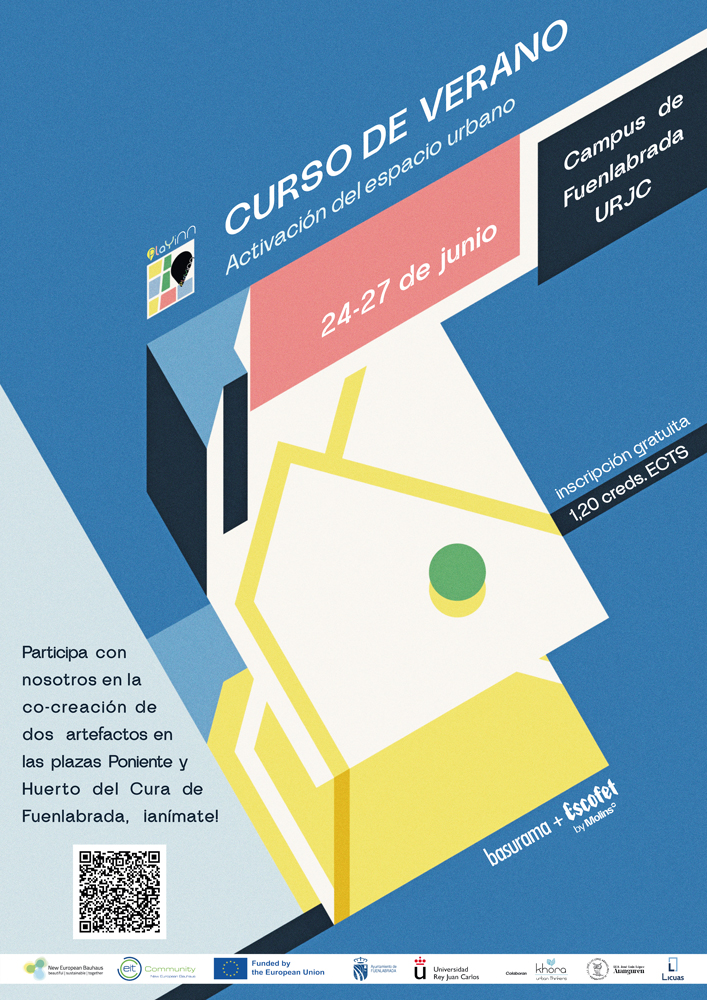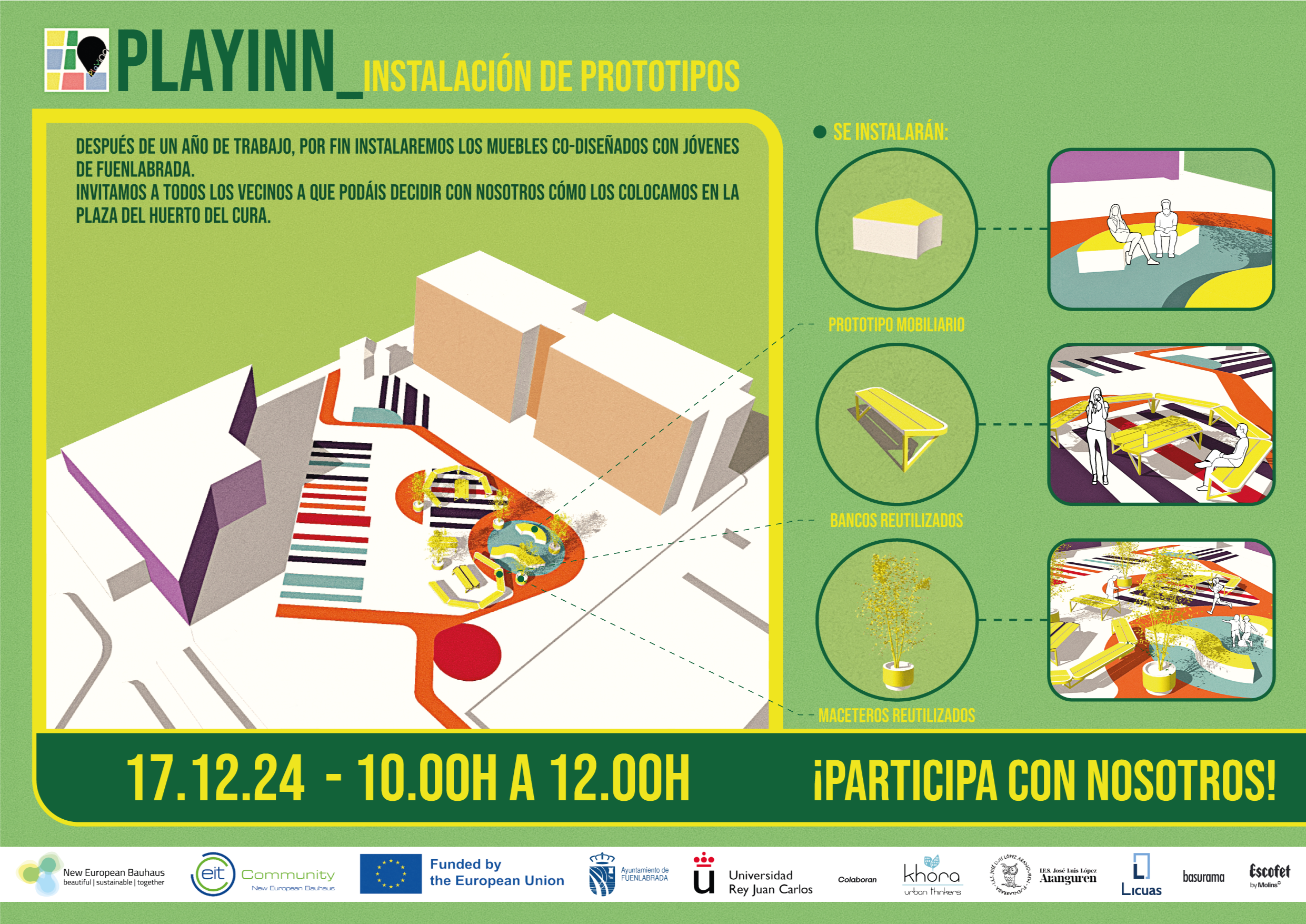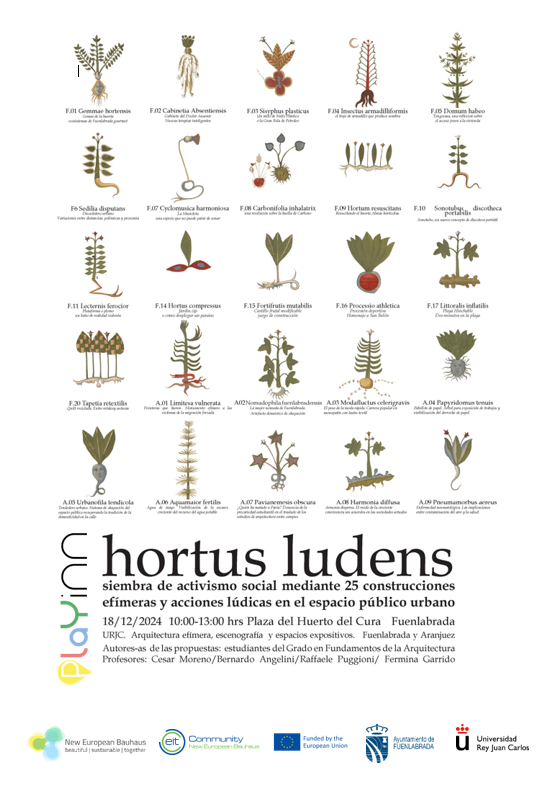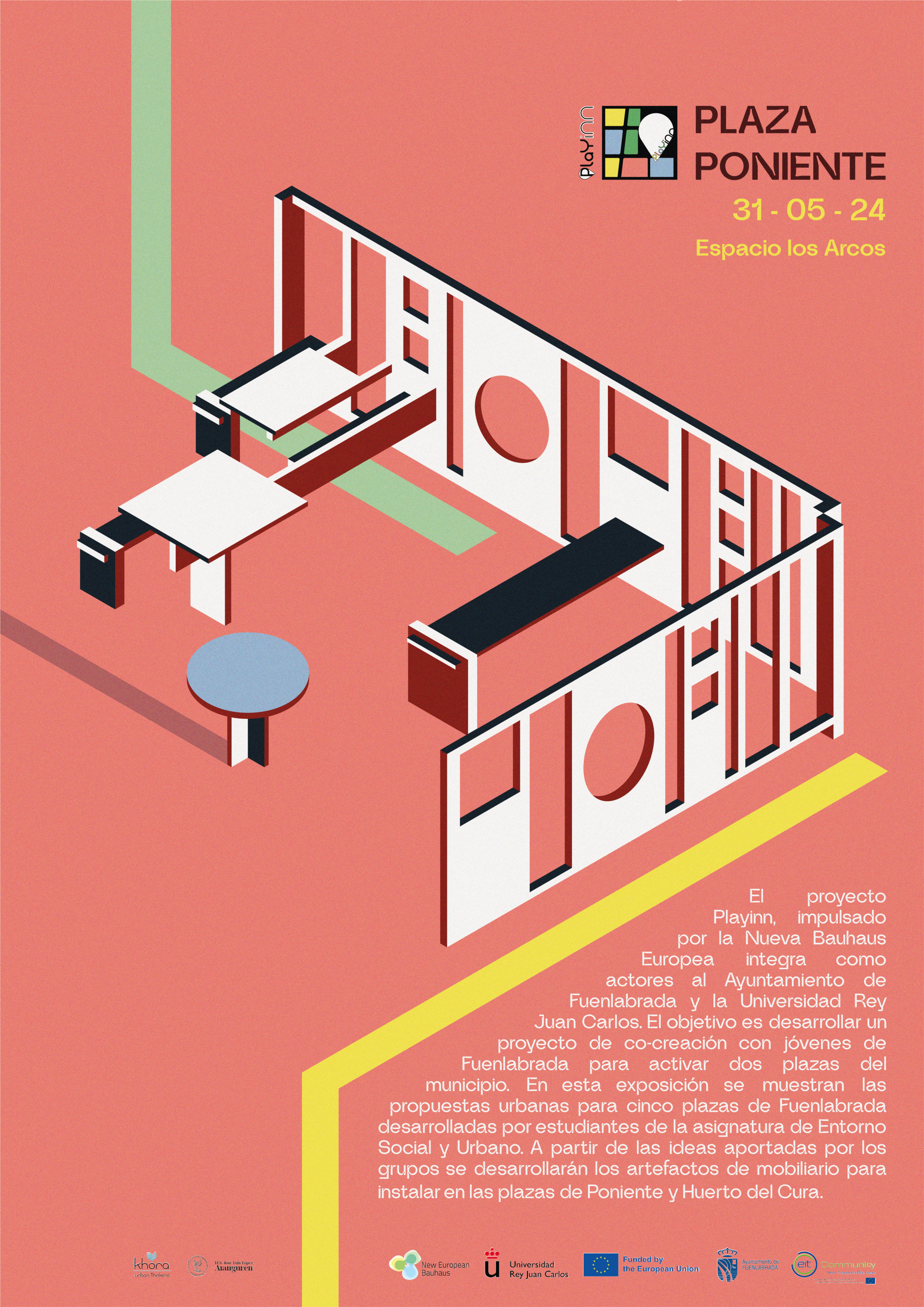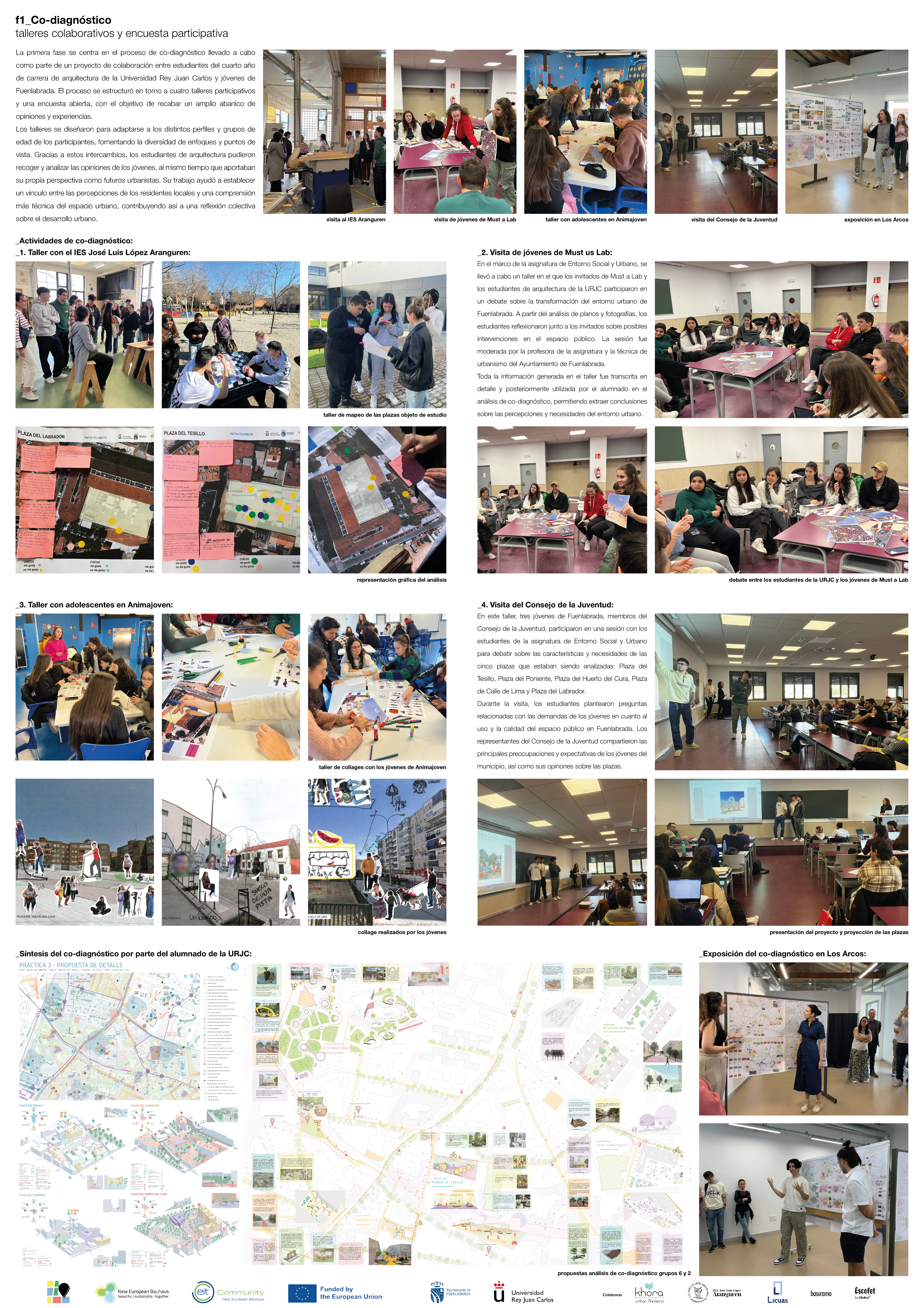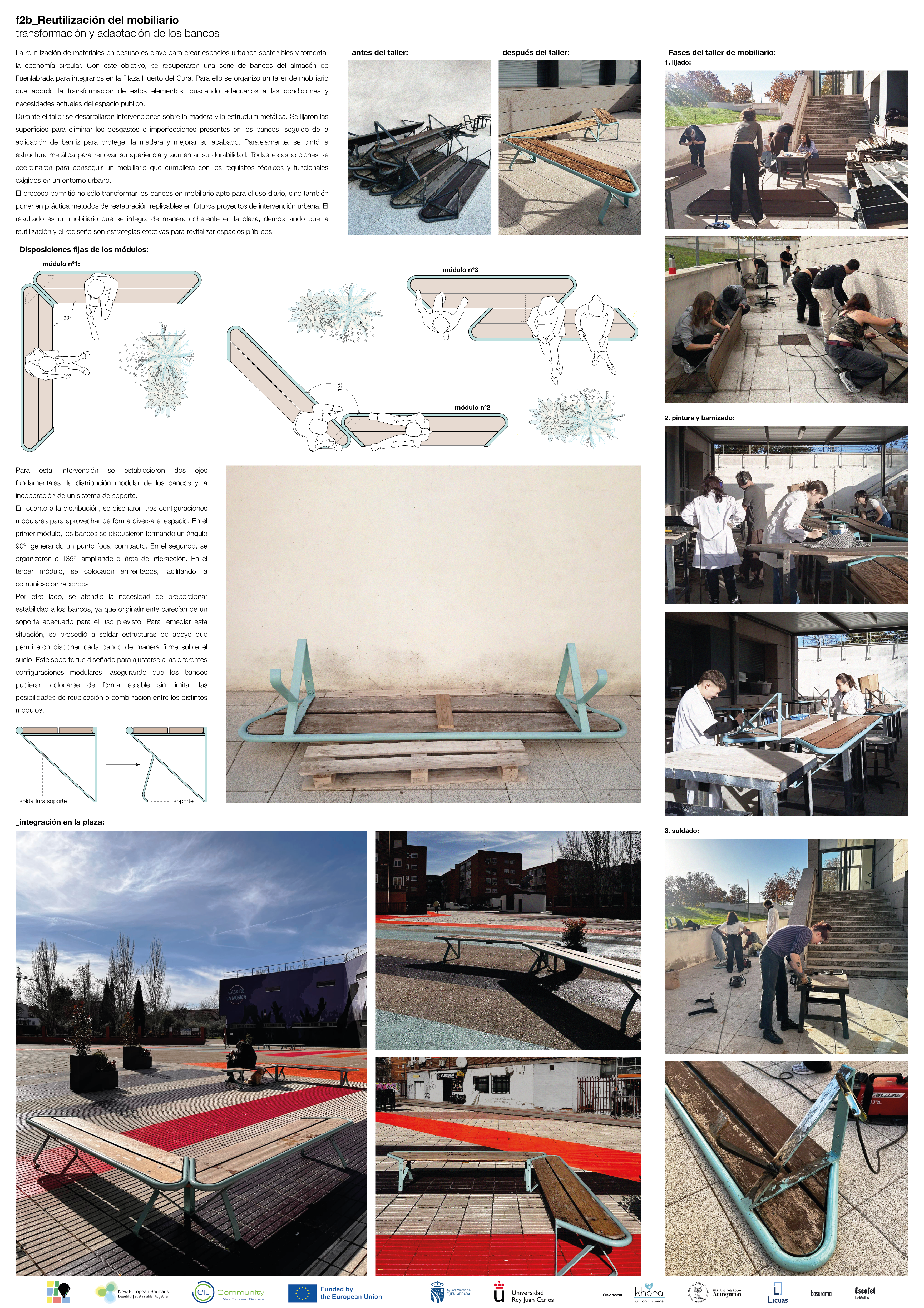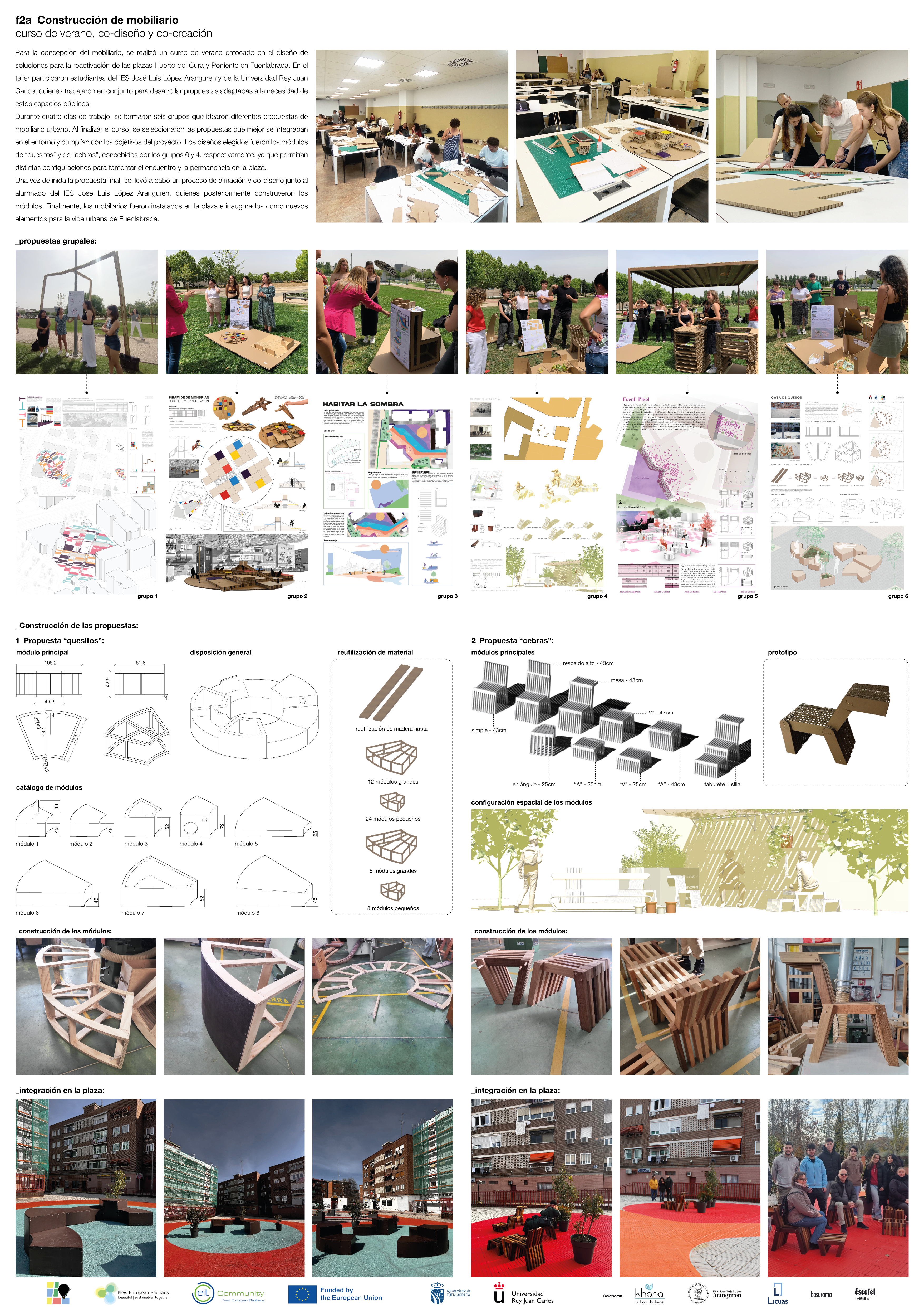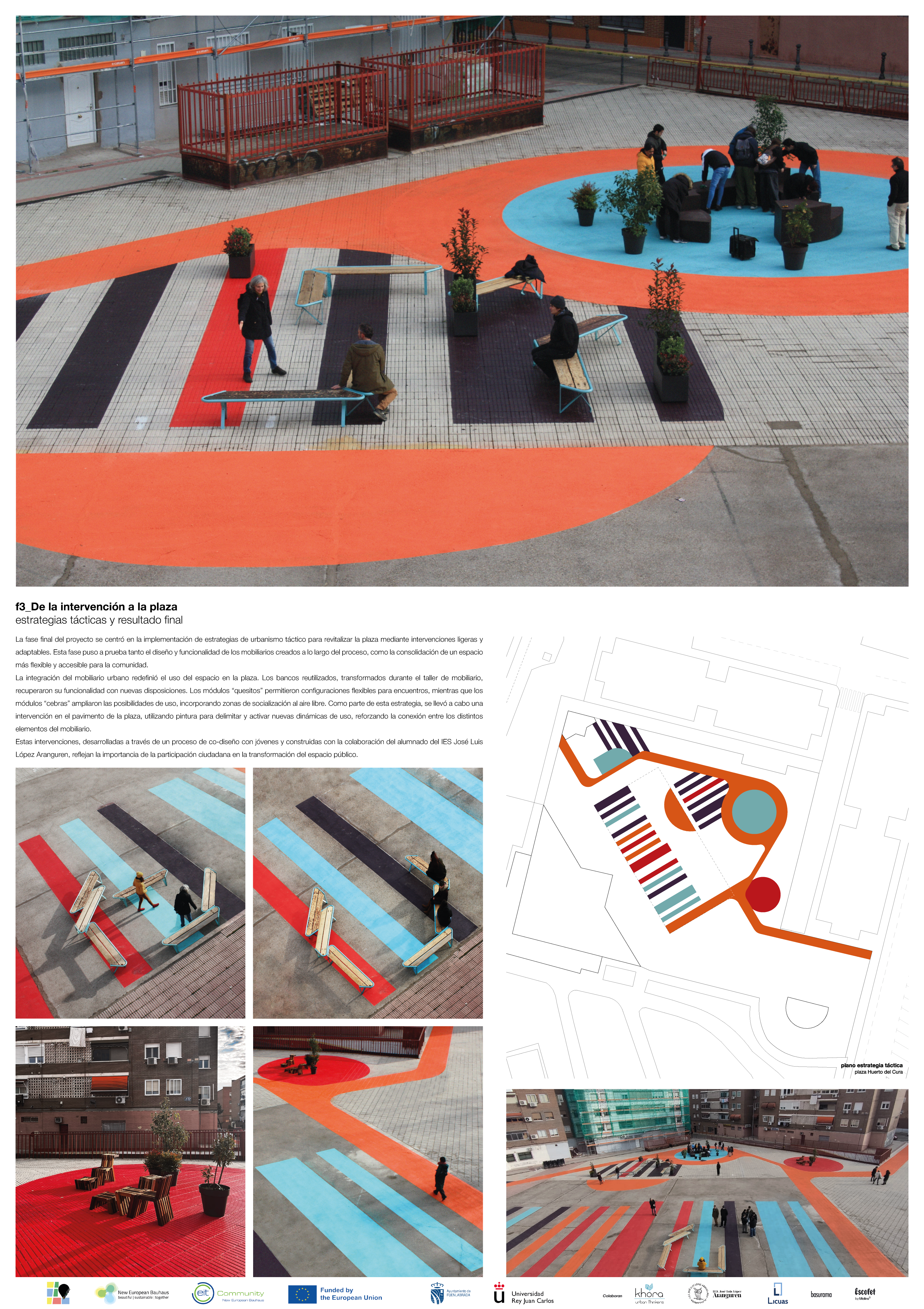Regaining a sense of belonging
plaYinn
Plazas for Youth Innovation
PlaYInn is a project designed to foster community and a sense of belonging among young by enhancing the quality of public plazas based on NEB criteria. It is an innovative, co-creative solution that improves public spaces through an adaptable, ephemeral design, meeting the evolving needs of adolescents and young citizens.
The project has been developed through a close collaboration between the City Council and the local university (URJC), applying an innovative prototyping methodology.
The project has been developed through a close collaboration between the City Council and the local university (URJC), applying an innovative prototyping methodology.
Spain
Local
Fuenlabrada
Mainly urban
It refers to other types of transformations (soft investment)
Yes
2024-12-31
Yes
Co-create NEB Call EIT Urban Mobility
No
No
As a representative of an organisation, in partnership with other organisations
The main objective of PlaYInn was to actively engage young people in shaping public spaces. The project aimed to involve young people in the entire decision-making process: from selecting the location to co-designing the urban elements and determining their placement within the plazas.
The project was led by the City Council of Fuenlabrada (Departments of Urban Planning, Circular Economy, Children and Youth, and Education) in collaboration with Rey Juan Carlos University (Urban Planning degree). The active involvement of young citizens was essential in revitalizing plazas that were no longer used by this age group, following NEB criteria. The project followed a structured work plan with four key phases (Co-Diagnosis, Co-Design, Prototyping, and M&E), supported by a transversal coordination activity.
Throughout the project, young participants played a key role in designing urban furniture prototypes that addressed their needs. During the diagnostic phase, they identified key challenges, followed by a co-creation phase that brought together architecture students and local youth. The design process was followed by the prototyping phase which was supported by Carpentry students.
As a result, young participants not only contributed to the design and transformation of public spaces but also felt empowered by their active role in shaping their city. The project fostered a strong sense of ownership, encouraging them to engage more with urban development processes.
Additionally, the project strengthened collaboration between institutions, local businesses, and the community, showcasing how participatory urban design can lead to innovative, sustainable solutions.
The two produced urban prototypes, crafted by students were installed in two public plazas. The success of PlaYInn demonstrated that involving young people in city planning not only improves public spaces but also creates a more inclusive and engaged civic culture.
The project was led by the City Council of Fuenlabrada (Departments of Urban Planning, Circular Economy, Children and Youth, and Education) in collaboration with Rey Juan Carlos University (Urban Planning degree). The active involvement of young citizens was essential in revitalizing plazas that were no longer used by this age group, following NEB criteria. The project followed a structured work plan with four key phases (Co-Diagnosis, Co-Design, Prototyping, and M&E), supported by a transversal coordination activity.
Throughout the project, young participants played a key role in designing urban furniture prototypes that addressed their needs. During the diagnostic phase, they identified key challenges, followed by a co-creation phase that brought together architecture students and local youth. The design process was followed by the prototyping phase which was supported by Carpentry students.
As a result, young participants not only contributed to the design and transformation of public spaces but also felt empowered by their active role in shaping their city. The project fostered a strong sense of ownership, encouraging them to engage more with urban development processes.
Additionally, the project strengthened collaboration between institutions, local businesses, and the community, showcasing how participatory urban design can lead to innovative, sustainable solutions.
The two produced urban prototypes, crafted by students were installed in two public plazas. The success of PlaYInn demonstrated that involving young people in city planning not only improves public spaces but also creates a more inclusive and engaged civic culture.
Community Engagement and Empowerment
Experimental Rapid Prototyping
Inclusive and Beautiful Public Realm
Public Space as Social Justice Catalyst
Youth Inclusion and Accessibility
Given that the project was designed following NEB criteria and that its vision and values have been fully embraced by the Fuenlabrada City Council, PlaYInn not only required active youth participation throughout all phases of experimentation but also prioritized the reuse of materials and elements that were no longer in use. These materials, stored by the City Council with the aim of giving them a second life, became key components in the prototyping sustainable approach.
In this sense, the Fuenlabrada’s Municipality has a catalogue of urban elements removed from the streets, such as litter bins, benches, flowerpots, etc., which were available to the young people to create furniture prototypes. In fact, the prototypes, called 'perritos', were made from the wood of the Madrid model benches that were in the warehouse.
This shows the great potential that cities have to reuse elements and make sustainability and circularity one of their pillars. In this sense, plaYinn has had important allies in the reuse process and with the participation of companies in the urban furniture sector who have also seen the potential in this type of co-design project.
In this sense, the Fuenlabrada’s Municipality has a catalogue of urban elements removed from the streets, such as litter bins, benches, flowerpots, etc., which were available to the young people to create furniture prototypes. In fact, the prototypes, called 'perritos', were made from the wood of the Madrid model benches that were in the warehouse.
This shows the great potential that cities have to reuse elements and make sustainability and circularity one of their pillars. In this sense, plaYinn has had important allies in the reuse process and with the participation of companies in the urban furniture sector who have also seen the potential in this type of co-design project.
From an aesthetic point of view, it should be pointed out that one of the plazas in which the work was carried out is a bare plaza over a car park in the neighbourhood, with no features or attractions, so that it was just a place for people to pass through. In addition, the plaza is located next to Fuenlabrada's 'Casa de la Música', a space with rehearsal rooms for local groups and a concert and activity hall, making it a meeting place for young people.
The action carried out has completely changed the configuration of the plaza in several ways:
On the one hand, the tactical urban action carried out with the paint on the ground in itself adds beauty to the space. In addition, the aim of the painting was to recreate the agricultural origins of the city by simulating the terraces of the market gardens that used to occupy the space.
The installation of diverse seating areas has transformed the plaza from a passageway into a place to gather and spend time, significantly enriching the experience of those who use it. Additionally, representatives from the City Council recognized the plaza’s potential to host new municipal activities.
Finally, PlaYinn made possible that local policymakers recognized the immense potential of young people, acknowledging their enthusiasm for actively participating in co-decision processes and their commitment to transforming and revitalizing their city. Young people bring fresh perspectives, creativity, and a strong sense of ownership, proving that youth-driven initiatives can lead to meaningful and sustainable urban change. By replicating this experience and hearing young voices, local authorities are not only fostering a more inclusive decision-making process but also ensuring that cities evolve in ways that truly reflect the needs and aspirations of future generations.
The action carried out has completely changed the configuration of the plaza in several ways:
On the one hand, the tactical urban action carried out with the paint on the ground in itself adds beauty to the space. In addition, the aim of the painting was to recreate the agricultural origins of the city by simulating the terraces of the market gardens that used to occupy the space.
The installation of diverse seating areas has transformed the plaza from a passageway into a place to gather and spend time, significantly enriching the experience of those who use it. Additionally, representatives from the City Council recognized the plaza’s potential to host new municipal activities.
Finally, PlaYinn made possible that local policymakers recognized the immense potential of young people, acknowledging their enthusiasm for actively participating in co-decision processes and their commitment to transforming and revitalizing their city. Young people bring fresh perspectives, creativity, and a strong sense of ownership, proving that youth-driven initiatives can lead to meaningful and sustainable urban change. By replicating this experience and hearing young voices, local authorities are not only fostering a more inclusive decision-making process but also ensuring that cities evolve in ways that truly reflect the needs and aspirations of future generations.
The key objectives of our project in terms of inclusion were to ensure not only beauty and sustainability but also accessibility, and participatory governance, while promoting inclusive design principles and new social models. We aimed to create a public space that was not only physically accessible to all, but also welcoming and engaging for a diverse range of users. The project was designed with the needs of different groups in mind, including young people, local residents, and the broader community.
The project was carried out in a highly inclusive manner: during the diagnostic phase, many different groups were consulted. Additionally, during the design phase, the general public was invited to review the designs, and together, they selected the ones that best met the NEB criteria. The entire process ensured that the final result reflected the needs and aspirations of the local population. Furthermore, the installation took place during a festive event, where all participants, young people and local citizens alike, came together to contribute, reinforcing a sense of community ownership and collective participation.
By promoting a collaborative approach and focusing on inclusive design, the project demonstrated how public spaces can be revitalized in a way that empowers and unites people from all walks of life. It serves as an example of how inclusivity can be effectively integrated into urban development, fostering social cohesion and creating spaces that truly belong to everyone.
The project was carried out in a highly inclusive manner: during the diagnostic phase, many different groups were consulted. Additionally, during the design phase, the general public was invited to review the designs, and together, they selected the ones that best met the NEB criteria. The entire process ensured that the final result reflected the needs and aspirations of the local population. Furthermore, the installation took place during a festive event, where all participants, young people and local citizens alike, came together to contribute, reinforcing a sense of community ownership and collective participation.
By promoting a collaborative approach and focusing on inclusive design, the project demonstrated how public spaces can be revitalized in a way that empowers and unites people from all walks of life. It serves as an example of how inclusivity can be effectively integrated into urban development, fostering social cohesion and creating spaces that truly belong to everyone.
Citizens who benefit from or are affected by the project, as well as civil society, have played an integral role throughout the entire process. From the beginning, young people and local residents were actively involved in both the co-design and decision-making stages, ensuring that the final outcomes truly reflected the needs and aspirations of the community.
During the diagnostic phase, various community groups were consulted to identify key challenges and priorities for the revitalization of public spaces. In the co-design phase, the general public was invited to review and select design proposals, ensuring that the designs aligned with the NEB criteria and catered to the diverse needs of the population.
The level of participation was highly inclusive, with hands-on involvement in prototyping, installation, and the celebration of the final project. Citizens, particularly the youth, were not just passive recipients but active contributors, shaping the urban environment in which they live. This active participation fostered a strong sense of ownership and empowerment, reinforcing the idea that public spaces should reflect the community's values and needs.
The impact of this participation has been profound. It has strengthened social cohesion, empowered local citizens, and created a more inclusive urban space. The collaborative approach has also increased the long-term sustainability of the project, as the community feels a sense of responsibility for maintaining and using the transformed spaces. Overall, the citizens' involvement has been pivotal in creating spaces that are not only physically accessible but also socially engaging and reflective of the diverse voices within the community
During the diagnostic phase, various community groups were consulted to identify key challenges and priorities for the revitalization of public spaces. In the co-design phase, the general public was invited to review and select design proposals, ensuring that the designs aligned with the NEB criteria and catered to the diverse needs of the population.
The level of participation was highly inclusive, with hands-on involvement in prototyping, installation, and the celebration of the final project. Citizens, particularly the youth, were not just passive recipients but active contributors, shaping the urban environment in which they live. This active participation fostered a strong sense of ownership and empowerment, reinforcing the idea that public spaces should reflect the community's values and needs.
The impact of this participation has been profound. It has strengthened social cohesion, empowered local citizens, and created a more inclusive urban space. The collaborative approach has also increased the long-term sustainability of the project, as the community feels a sense of responsibility for maintaining and using the transformed spaces. Overall, the citizens' involvement has been pivotal in creating spaces that are not only physically accessible but also socially engaging and reflective of the diverse voices within the community
At the local level, one of the key stakeholders was the Vocational Training Institute, specifically its Carpentry course. Both students and teachers actively participated in all phases of the project, playing a crucial role in the creation of wooden prototypes, which were manufactured within the institute’s facilities.
As mentioned, the University was also a strategic partner, contributing academic and technical knowledge that enriched the project’s development.
A fundamental stakeholder was the city's youth collective, who were present throughout all stages of the process, bringing fresh ideas, creativity, and active engagement to the project.
At the regional/national level, we collaborated with a diverse range of stakeholders, such as:
• Khora Consulting, a team of experts from various urban disciplines dedicated to developing innovative solutions for cities. Khora was the consultant hired by the municipality for the monitoring and evaluation of the project, providing a valuable global vision.
• BASURAMA Collective, an organization focused on research, creation, and cultural and environmental production. Their work centers on production processes, waste generation, and the creative opportunities they offer. BASURAMA was actively involved in all stages of the project and played a key role in the reuse and recycling of urban elements.
• LICUAS and ESCOFET, leading companies in the urban furniture sector, contributed by participating in the summer course training and evaluating the feasibility of the prototypes for potential future commercialization.
At the European level, the EIT provided the project with two experts—one specializing in the co-creation process with young citizens and the other focusing on the commercialization of the ideas emerging from the co-creation process. Their involvement was instrumental in implementing innovative actions throughout the project.
As mentioned, the University was also a strategic partner, contributing academic and technical knowledge that enriched the project’s development.
A fundamental stakeholder was the city's youth collective, who were present throughout all stages of the process, bringing fresh ideas, creativity, and active engagement to the project.
At the regional/national level, we collaborated with a diverse range of stakeholders, such as:
• Khora Consulting, a team of experts from various urban disciplines dedicated to developing innovative solutions for cities. Khora was the consultant hired by the municipality for the monitoring and evaluation of the project, providing a valuable global vision.
• BASURAMA Collective, an organization focused on research, creation, and cultural and environmental production. Their work centers on production processes, waste generation, and the creative opportunities they offer. BASURAMA was actively involved in all stages of the project and played a key role in the reuse and recycling of urban elements.
• LICUAS and ESCOFET, leading companies in the urban furniture sector, contributed by participating in the summer course training and evaluating the feasibility of the prototypes for potential future commercialization.
At the European level, the EIT provided the project with two experts—one specializing in the co-creation process with young citizens and the other focusing on the commercialization of the ideas emerging from the co-creation process. Their involvement was instrumental in implementing innovative actions throughout the project.
Playinn integrated multiple disciplines and fields of knowledge, fostering a interdisciplinary approach.
1. Urban Planning and Governance
o The project was framed within Fuenlabrada’s Urban Agenda, aligned with the SDGs, particularly strategic axis 1, Regenerative Culture, and its strategic line L1.6, which promotes participatory governance through co-creation and co-governance. Young citizens played a crucial role in selecting the plazas for intervention and actively contributing to the co-design process.
2. Architecture and Tactical Urbanism
o Rey Juan Carlos University contributed the architectural vision of the designs and prototypes. The project incorporated elements of tactical urbanism and ephemeral architecture.
3. Social Inclusion and Community Engagement
o The project also addressed strategic axis 2, Identity and Cohesion, specifically L2.1 (ensuring the inclusion of vulnerable groups) and L2.2 (promoting inclusive and unique urban design). Young people, often underrepresented in urban decision-making, were empowered to reclaim public spaces as their own through active participation.
4. Sustainability and Circular Economy
o A strong emphasis was placed on the reuse of materials and circular economy principles. Instead of purchasing new materials, the project repurposed municipal resources, fostering sustainability and equipping young participants with knowledge of eco-friendly urban interventions.
Interdisciplinary Interaction and Added Value
Urban planners, architects, sustainability experts, and young citizens co-created solutions, combining governance, architecture, and social inclusion. This collaboration:
• Fostered holistic, inclusive, and sustainable urban interventions.
• Engaged youth in decision-making while enhancing their knowledge of urbanism and sustainability.
• Strengthened civic engagement and ownership of public spaces.
By integrating these disciplines, the project successfully revitalized plazas.
1. Urban Planning and Governance
o The project was framed within Fuenlabrada’s Urban Agenda, aligned with the SDGs, particularly strategic axis 1, Regenerative Culture, and its strategic line L1.6, which promotes participatory governance through co-creation and co-governance. Young citizens played a crucial role in selecting the plazas for intervention and actively contributing to the co-design process.
2. Architecture and Tactical Urbanism
o Rey Juan Carlos University contributed the architectural vision of the designs and prototypes. The project incorporated elements of tactical urbanism and ephemeral architecture.
3. Social Inclusion and Community Engagement
o The project also addressed strategic axis 2, Identity and Cohesion, specifically L2.1 (ensuring the inclusion of vulnerable groups) and L2.2 (promoting inclusive and unique urban design). Young people, often underrepresented in urban decision-making, were empowered to reclaim public spaces as their own through active participation.
4. Sustainability and Circular Economy
o A strong emphasis was placed on the reuse of materials and circular economy principles. Instead of purchasing new materials, the project repurposed municipal resources, fostering sustainability and equipping young participants with knowledge of eco-friendly urban interventions.
Interdisciplinary Interaction and Added Value
Urban planners, architects, sustainability experts, and young citizens co-created solutions, combining governance, architecture, and social inclusion. This collaboration:
• Fostered holistic, inclusive, and sustainable urban interventions.
• Engaged youth in decision-making while enhancing their knowledge of urbanism and sustainability.
• Strengthened civic engagement and ownership of public spaces.
By integrating these disciplines, the project successfully revitalized plazas.
The innovative nature of this project for Fuenlabrada City Council lies in its approach to urban renewal. Traditionally, when the City Council intervened in public spaces, decisions were made without directly engaging potential users to assess their needs or preferences.
This project introduced a co-creation and co-design process, actively involving citizens in shaping their urban environment. By integrating the community throughout the entire renovation process, the initiative has transformed how public spaces are redesigned—moving from a top-down approach to a collaborative, user-centered model.
A key innovation was the commitment to sustainability and circular economy principles, ensuring that the interventions were carried out using recycled materials rather than new resources. This approach minimized environmental impact while promoting creative reuse.
Additionally, the project was guided by the principles of the New European Bauhaus, blending sustainability, aesthetics, and inclusivity to create spaces that are not only functional but also beautiful and accessible for all.
This participatory and eco-conscious method not only ensures that urban interventions better reflect the real needs of the community but also strengthens the sense of ownership and belonging among residents. As a result, public spaces become more meaningful and valued, fostering a stronger connection between people and their city.
This project introduced a co-creation and co-design process, actively involving citizens in shaping their urban environment. By integrating the community throughout the entire renovation process, the initiative has transformed how public spaces are redesigned—moving from a top-down approach to a collaborative, user-centered model.
A key innovation was the commitment to sustainability and circular economy principles, ensuring that the interventions were carried out using recycled materials rather than new resources. This approach minimized environmental impact while promoting creative reuse.
Additionally, the project was guided by the principles of the New European Bauhaus, blending sustainability, aesthetics, and inclusivity to create spaces that are not only functional but also beautiful and accessible for all.
This participatory and eco-conscious method not only ensures that urban interventions better reflect the real needs of the community but also strengthens the sense of ownership and belonging among residents. As a result, public spaces become more meaningful and valued, fostering a stronger connection between people and their city.
The methodology used in the implementation of the project was participatory action, since the main goal was co-creation process together with young people.
For instance, in the co-diagnosis phase, a series of working groups and surveys were carried out to gather young people's opinions, which were developed by young people.
During the co-design phase, which took place during the summer course, participatory action was present from the beginning, as most of the time was devoted to the creation of prototypes. The course was open to all young people, regardless of their knowledge of architecture.
The final phases of prototyping and installation were developed entirely by the young people (with the supervision of the teachers).
For instance, in the co-diagnosis phase, a series of working groups and surveys were carried out to gather young people's opinions, which were developed by young people.
During the co-design phase, which took place during the summer course, participatory action was present from the beginning, as most of the time was devoted to the creation of prototypes. The course was open to all young people, regardless of their knowledge of architecture.
The final phases of prototyping and installation were developed entirely by the young people (with the supervision of the teachers).
The project, as a whole, is highly transferable and adaptable to different contexts. The key lies in strong leadership and the ability to engage relevant partners and stakeholders who are committed to the process.
Once this foundation is established, the project's methodology can be applied regardless of the size of the municipality, its urban or rural setting, or the target population (youth, elderly, or the broader community).
Key Transferable Elements
1. Participatory Methodology
o The co-creation and co-design approach empowers citizens by giving them a voice and decision-making capacity in shaping their environment.
o While participation levels may vary depending on prior civic engagement experiences, strategies can be adapted to encourage involvement.
o A key lesson learned from PLAYINN is the importance of scheduling activities in alignment with the availability of target groups.
2. Sustainable and Circular Economy Practices
o The project demonstrates how urban interventions can be carried out using recycled materials, reducing environmental impact and promoting circular economy principles.
o This approach can be replicated in different locations by leveraging existing local resources and municipal storage facilities.
3. Collaboration with Educational Institutions
o The involvement of a Vocational Training Institute was crucial for the fabrication of urban furniture prototypes, given the need for specialized skills and equipment.
o This model can be adapted by partnering with technical schools, universities, or local businesses that have the necessary expertise and infrastructure.
Once this foundation is established, the project's methodology can be applied regardless of the size of the municipality, its urban or rural setting, or the target population (youth, elderly, or the broader community).
Key Transferable Elements
1. Participatory Methodology
o The co-creation and co-design approach empowers citizens by giving them a voice and decision-making capacity in shaping their environment.
o While participation levels may vary depending on prior civic engagement experiences, strategies can be adapted to encourage involvement.
o A key lesson learned from PLAYINN is the importance of scheduling activities in alignment with the availability of target groups.
2. Sustainable and Circular Economy Practices
o The project demonstrates how urban interventions can be carried out using recycled materials, reducing environmental impact and promoting circular economy principles.
o This approach can be replicated in different locations by leveraging existing local resources and municipal storage facilities.
3. Collaboration with Educational Institutions
o The involvement of a Vocational Training Institute was crucial for the fabrication of urban furniture prototypes, given the need for specialized skills and equipment.
o This model can be adapted by partnering with technical schools, universities, or local businesses that have the necessary expertise and infrastructure.
The project addresses two main challenges
1. The sense of belonging to a community. In a world where we live in increasingly large and individualistic cities, it is essential to create spaces where we can share time with others in the open air. Fuenlabrada is developing spaces where citizens can spend time together (such as the redesign of public areas or the creation of an urban park that will house the fair), and the plaYinn project is an example of this.
2. Recycling urban elements. The generation of waste and its management is one of the major problems facing humanity. The ability to reuse elements on a local scale, so that they do not become waste and can have a new life, can mean a change on a global scale.
1. The sense of belonging to a community. In a world where we live in increasingly large and individualistic cities, it is essential to create spaces where we can share time with others in the open air. Fuenlabrada is developing spaces where citizens can spend time together (such as the redesign of public areas or the creation of an urban park that will house the fair), and the plaYinn project is an example of this.
2. Recycling urban elements. The generation of waste and its management is one of the major problems facing humanity. The ability to reuse elements on a local scale, so that they do not become waste and can have a new life, can mean a change on a global scale.
The project has achieved significant results & impacts aligned by generating social, environmental, & urban improvements for both direct and indirect beneficiaries
Key Results and Impacts
1. Enhanced Citizen Participation and Co-Governance
Young people were actively involved in the co-design and decision-making processes for urban spaces, fostering a new model of participatory governance in the city
This has strengthened civic engagement and empowered local youth as active agents in urban transformation
2. Revitalization of Public Spaces
Degraded and underutilized plazas were transformed into functional, inclusive, and community-driven spaces
The incorporation of natural elements contributed to the renaturalization of urban areas
3. Sustainability and Circular Economy
The project promoted waste reduction by reusing municipal materials, aligning with circular economy principles and reducing environmental impact
It served as an educational experience, raising awareness among young participants about sustainable urban design and material reuse
4. Strengthened Social Inclusion and Belonging
The initiative prioritized vulnerable groups, particularly young people, giving them a voice in shaping their city
By involving residents in the transformation of public spaces, the project fostered a stronger sense of ownership and community identity
Benefits for Direct and Indirect Beneficiaries
Direct beneficiaries: Young gained experience in urban planning, sustainability, and co-governance, as well as local residents who now have more inclusive and engaging public spaces
Indirect beneficiaries: The broader community, which benefits from a more sustainable, participatory, and livable city, as well as local institutions that can replicate this co-creation model in future urban projects
Ultimately, the project has set a precedent for more inclusive, sustainable, and participatory urban renewal, offering a replicable model for other cities facing similar challenges
Key Results and Impacts
1. Enhanced Citizen Participation and Co-Governance
Young people were actively involved in the co-design and decision-making processes for urban spaces, fostering a new model of participatory governance in the city
This has strengthened civic engagement and empowered local youth as active agents in urban transformation
2. Revitalization of Public Spaces
Degraded and underutilized plazas were transformed into functional, inclusive, and community-driven spaces
The incorporation of natural elements contributed to the renaturalization of urban areas
3. Sustainability and Circular Economy
The project promoted waste reduction by reusing municipal materials, aligning with circular economy principles and reducing environmental impact
It served as an educational experience, raising awareness among young participants about sustainable urban design and material reuse
4. Strengthened Social Inclusion and Belonging
The initiative prioritized vulnerable groups, particularly young people, giving them a voice in shaping their city
By involving residents in the transformation of public spaces, the project fostered a stronger sense of ownership and community identity
Benefits for Direct and Indirect Beneficiaries
Direct beneficiaries: Young gained experience in urban planning, sustainability, and co-governance, as well as local residents who now have more inclusive and engaging public spaces
Indirect beneficiaries: The broader community, which benefits from a more sustainable, participatory, and livable city, as well as local institutions that can replicate this co-creation model in future urban projects
Ultimately, the project has set a precedent for more inclusive, sustainable, and participatory urban renewal, offering a replicable model for other cities facing similar challenges

